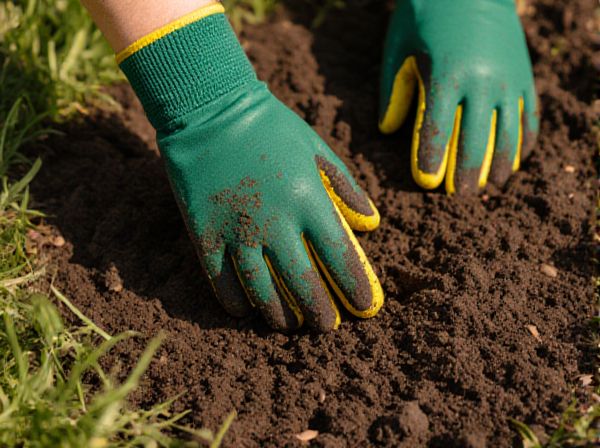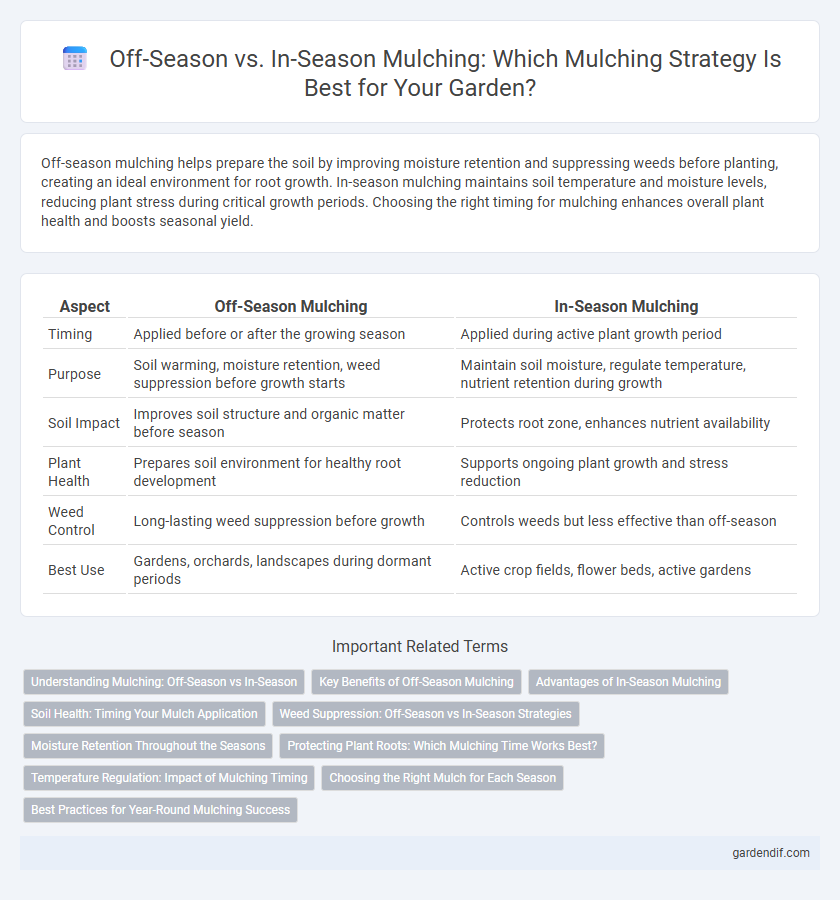
Off-season mulching vs In-season mulching Illustration
Off-season mulching helps prepare the soil by improving moisture retention and suppressing weeds before planting, creating an ideal environment for root growth. In-season mulching maintains soil temperature and moisture levels, reducing plant stress during critical growth periods. Choosing the right timing for mulching enhances overall plant health and boosts seasonal yield.
Table of Comparison
| Aspect | Off-Season Mulching | In-Season Mulching |
|---|---|---|
| Timing | Applied before or after the growing season | Applied during active plant growth period |
| Purpose | Soil warming, moisture retention, weed suppression before growth starts | Maintain soil moisture, regulate temperature, nutrient retention during growth |
| Soil Impact | Improves soil structure and organic matter before season | Protects root zone, enhances nutrient availability |
| Plant Health | Prepares soil environment for healthy root development | Supports ongoing plant growth and stress reduction |
| Weed Control | Long-lasting weed suppression before growth | Controls weeds but less effective than off-season |
| Best Use | Gardens, orchards, landscapes during dormant periods | Active crop fields, flower beds, active gardens |
Understanding Mulching: Off-Season vs In-Season
Off-season mulching involves applying mulch during dormant periods to protect soil from erosion, retain moisture, and regulate temperature before planting season begins. In-season mulching supports active plant growth by suppressing weeds, conserving soil moisture, and improving nutrient availability. Choosing the right timing for mulching enhances soil health and optimizes plant development throughout the growing cycle.
Key Benefits of Off-Season Mulching
Off-season mulching enhances soil moisture retention and improves nutrient availability by allowing organic matter to fully decompose before peak plant growth periods. It also reduces weed proliferation and soil erosion during dormant seasons, thereby promoting healthier root development. This proactive approach minimizes pest infestations and temperature fluctuations, ensuring stronger plant resilience during the growing season.
Advantages of In-Season Mulching
In-season mulching promotes optimal soil moisture retention and temperature regulation, enhancing plant growth during active development phases. By applying mulch when plants are actively growing, nutrient uptake improves, leading to healthier foliage and higher yields. This timing also helps suppress weeds more effectively, reducing competition for essential nutrients throughout the growing season.
Soil Health: Timing Your Mulch Application
Applying mulch during the off-season enhances soil moisture retention and suppresses weed growth before plant roots are actively growing, promoting early soil health benefits. In-season mulching supports temperature regulation and nutrient conservation while plants develop, directly contributing to optimal root function and microbial activity. Proper timing of mulch application maximizes soil aeration, organic matter decomposition, and water infiltration, crucial elements for maintaining long-term soil fertility.
Weed Suppression: Off-Season vs In-Season Strategies
Off-season mulching effectively suppresses weeds by creating a physical barrier that prevents seed germination during dormant periods, reducing weed pressure before the growing season begins. In-season mulching continues to inhibit weed growth by blocking sunlight and maintaining soil moisture, but is often less effective in preventing initial weed emergence compared to off-season applications. Combining both strategies maximizes weed control throughout the year, optimizing crop health and soil quality.
Moisture Retention Throughout the Seasons
Off-season mulching plays a critical role in preserving soil moisture by reducing evaporation during dormant months, ensuring that soil remains hydrated for the upcoming growing season. In-season mulching continues to enhance moisture retention by minimizing surface drying caused by direct sunlight and wind, supporting healthy plant growth and reducing irrigation needs. Both practices collectively optimize water conservation, stabilize soil temperature fluctuations, and enhance overall soil health throughout varying seasonal conditions.
Protecting Plant Roots: Which Mulching Time Works Best?
Off-season mulching provides a protective barrier that helps insulate plant roots from extreme temperature fluctuations, reducing stress during dormant periods. In-season mulching enhances moisture retention and temperature regulation when plants actively grow, promoting healthy root development. Choosing the optimal mulching time depends on the specific plant species and local climate conditions to maximize root protection and overall plant health.
Temperature Regulation: Impact of Mulching Timing
Off-season mulching effectively lowers soil temperature by insulating the ground during colder months, preserving moisture and preventing frost damage. In-season mulching maintains consistent soil temperature throughout the growing period, reducing heat stress and promoting healthy root development. Timing mulching correctly enhances temperature regulation, optimizing plant growth and crop yield.
Choosing the Right Mulch for Each Season
Off-season mulching focuses on preparing soil for the next growing cycle by applying organic materials like straw or shredded leaves to improve moisture retention and protect roots during winter dormancy. In-season mulching uses lighter, breathable mulches such as bark chips or compost to regulate soil temperature, suppress weeds, and retain moisture throughout active plant growth periods. Selecting the right mulch involves matching materials to seasonal needs: insulating and enriching soil during dormant months, then promoting aeration and water conservation during growing seasons.
Best Practices for Year-Round Mulching Success
Off-season mulching preserves soil moisture and suppresses weed growth during dormant periods, enhancing soil structure and preventing erosion. In-season mulching supports active plant growth by maintaining optimal soil temperature and nutrient levels while reducing water evaporation. Combining both off-season and in-season mulching techniques tailored to specific plant needs ensures year-round garden health and sustainable landscape management.
Off-season mulching vs In-season mulching Infographic

 gardendif.com
gardendif.com